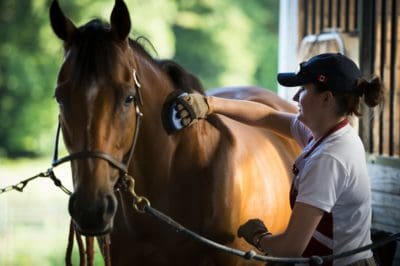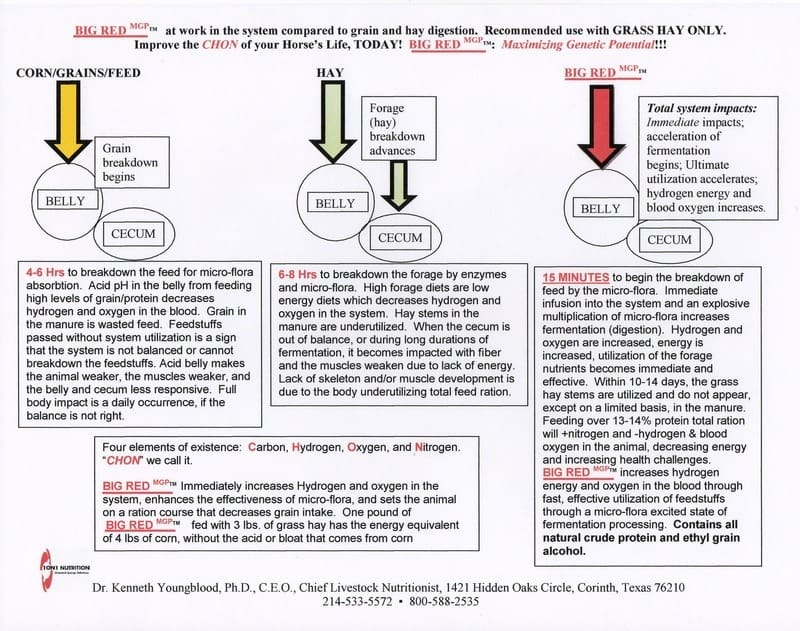
Introducing a revolutionary ultraviolet light energy that will reduce your
production costs and improve the quality of your animals.
Tests have shown that adding one pound of Big Red and three pounds of non-legume hay roughage will replace the grain energy of four pounds of corn energy in an equine’s diet. Meeting an equine’s energy requirements without requiring the equine to consume excessive amounts of grain, results in a significant weight gain per pound of feed consumed. Horses are better conditioned in terms of skeletal growth, muscle development, stronger estrous cycles, better conception rates, and display less laminitis.

Maximum Genetic Potential
Bigger, Stronger
The athletes currently on this program are healthier, more attentive, behaviorally consistent, and possess advanced strength qualities. Muscular-skeletal advancements are clearly visible with one month.

Grain Breakdown Begins- 4-6 Hrs to breakdown the feed for micro-flora absorption. Acid pH in the belly from feeding high levels of grain/protein decreases hydrogen and oxygen in the blood. Grin in the manure is wasted feed. Feed-stuffs passed without system utilization is a sign that the system is not balanced or cannot breakdown the feed-stuffs. Acid belly makes the animal weaker, the muscles weaker, and the belly and cecum less responsive.Full body impact is a daily occurrence, if the balance is not right.
Forage (hay) Breakdown Advances – 6-8 Hrs to breakdown the forage by enzymes and micro-flora. High forage diets are low energy diets which decreases hydrogen and oxygen in the system. Hay stems in the manure are underutilized . When the cecum is out of balance, or during long duration of fermentation, it becomes impacted with fiber and the muscles weaken due to lack of energy. Lack of skeleton and/or muscle development is due to the body under-utilizing total feed ration.
Total System Impacts: Immediate Impact- 15 MINUTES to begin the breakdown of feed by the micro-flora. Immediate infusion into the system and an explosive multiplication of micro-flora increases fermentation (digestion). Hydrogen and oxygen are increased, energy is increased, and utilization of the forage nutrients becomes immediate and effective.Within 10-14 days, the grass hay stems are utilized and do not appear, except on a limited basis,in the manure. Feeding over 13-14% protein total ration will +nitrogen and –hydrogen & blood oxygen in the animal, decreasing energy and increasing health challenges. Alcohol increases hydrogen energy and oxygen in the blood through fast, effective utilization of feed-stuffs through a micro-flora excited state of fermentation processing.Contains all natural crude protein and ethyl grain alcohol.
NEW PRODUCT!!
Big Red is formulated specifically for an all natural equine formula of 6% protein with no added nitrogen source. Drench, top fed, or add mix to a complete ration. This is new product line of 1ON1 NUTRITION, having utilized the application of these formulas in the field for decades. The advanced action impacts skeletal growth and bone/joint integrity of the animal in addition to the accelerated muscular and overall body score produced by use of the product.
The overall physical integrity, growth range and athletic ability of the animal is maximized as the Big Red regimen is utilized. This product increases blood oxygen. Health benefits include overall hoof integrity, less colic, and a more relaxed attitude with high energy benefits. Foals develop skeleton growth to equal or match their genetic potential. Carbohydrates, fats, sugars, and/or grains develop muscling or fat in advance of skeletal growth which limits the ability of the hooves, legs, ligaments/tendons, and all joints to reach growth potential thereby causing limitations of the these facets of physical structure and breakdowns under stress. Implementing the Big Red regimen in the potential or performing athlete equine for 30-60 days can assimilate a hydrogen energy potential excited by the oxygen rise maximizing all carbohydrates, protein, minerals, trace minerals and vitamins in the total diet.
Big Red works 30 times faster than carbohydrate sources of energy and does not create acidosis problems associated with high grain diets. Big Red increases the number of roughage-loving bacteria in the cecum and allows the body to assimilate the starches and sugars that are tied up in the stem of all forages. Laminitis and founder, also known as inflammation created by excess carbohydrates and/or protein, produces lactic acid which travels via the blood to the horny laminae in the hoof and is not repairable.
Introducing a revolutionary ultraviolet light energy (UV1-235) that will reduce your production costs and improve the quality of your animals. Tests have shown that adding one pound of Big Red and three pounds of non-legume hay roughage will replace the grain energy of four pounds of corn energy in an equine’s diet. Meeting an equine’s energy requirements without requiring the equine to consume excessive amounts of grain, results in a significant weight gain per pound of feed consumed. Horses are better conditioned in terms of skeletal growth, muscle development, stronger estrous cycles, better conception rates, and display less laminitis.
Energy needs will be met first at the expense of all nutrients. It is therefore necessary that the maximum energy required be received from Big Red This preserves the protein fed to meet the animal’s protein requirements. If energy is deficient, protein is used as a source of energy which is very expensive and highly inefficient.
- Carbohydrates from grain sources cause founder and acidosis when energy requirements are met with grain alone.
- Carbohydrates from cellulose sources are too bulky for the animal to consume sufficient quantities to fulfill energy requirements.
- Fat sources have palatability challenges and meeting requirements with fat sources is limited.
- If protein is used, the net energy gain is too expensive and the stress on the animal from excess ammonia production impacts the urinary tract.
Using Big Red as a high energy source aids in solving these problems and comes in a convenient and cost-effective application the animal is capable of consuming in a daily allotment diet. The recommended feeding is 1# per 500 weight. From the foaling barn to the arena and out onto the track, Big Red provides a lifetime of positive potential for the equine enthusiast, performance professional, trainer, breeder or investor by allowing any breed specimen to meet their genetic potential.If you are a veterinarian or nutritionist looking for an edge in your program, call me. I would be happy to hear from you.


